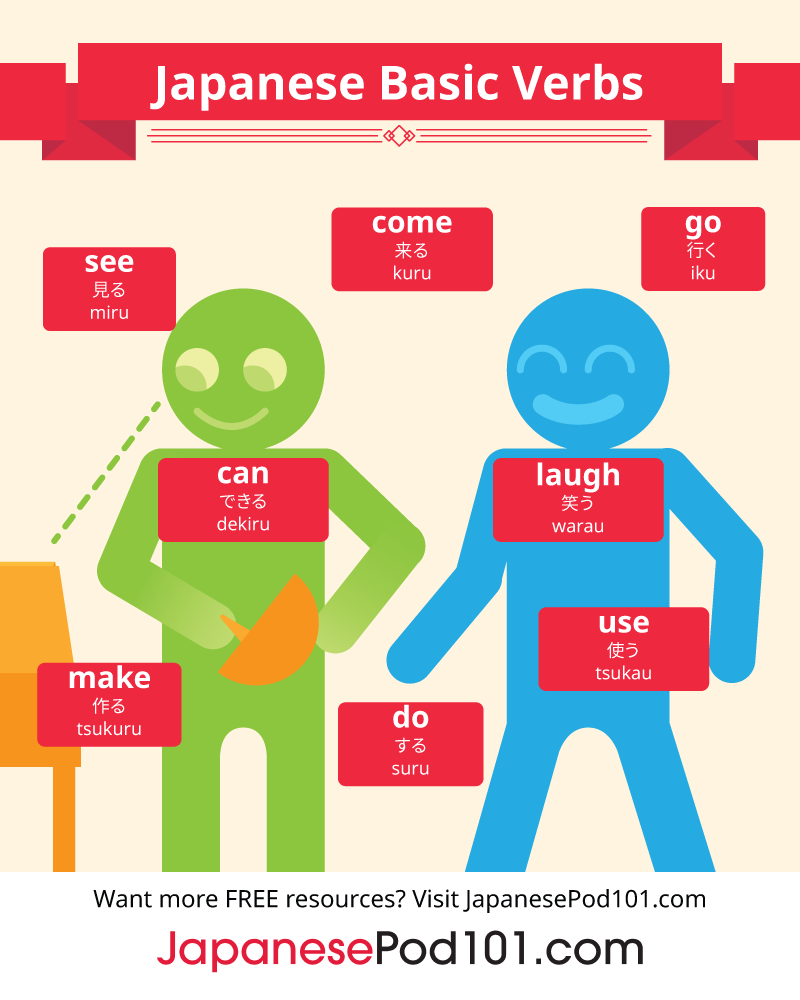
How many verbs do you think you use everyday? Verbs are the second-most frequently used part of speech in Japanese (after nouns), making it crucial to know and understand Japanese verb conjugation.
Compared to English, Japanese verb conjugation has distinct rules which might be difficult to understand at first. However, the good news is that Japanese verbs do not conjugate according to the speaker. Instead, the Japanese verb conjugation rules are the same for every grammatical person, or 人称 (ninshō), and any number of subjects (singular or plural). Therefore, you won’t be easily confused on how to conjugate Japanese verbs in this respect. In addition, there are very few irregular verb conjugations!
In this article, we’ll introduce the basics of Japanese verbs and Japanese verb conjugation, including verb groups and conjugation patterns. We’ll also provide examples for you.
Once you learn the conjugation patterns, you only have to apply the rules to any new verbs you learn! Let’s get started here at JapanesePod101.com!
- What is Conjugation?
- Japanese Verb Conjugation Groups
- Conjugation Patterns
- Conjugation Patterns for Irregular Verbs
- Let’s Practice!
- Conclusion: How JapanesePod101 Can Help You Learn More Japanese

1. What is Conjugation?

1 – What Does Conjugation Mean?
Conjugation in Japanese is described as the variation of the form of a certain part of speech—such as verbs—which is influenced by certain elements. These include: voice, mood, tense, and politeness level.
In Japanese, there are four parts of speech which have conjugation:
- 動詞 (dōshi) — Verb
- 助動詞 (jodōshi) — Auxiliary Verb
- 形容詞 (keiyōshi) — Adjective
- 形容動詞 (keiyōdōshi) — Adjective Verb
In this article, we’ll just be focusing on Japanese verb conjugations so we can explain in better detail.
2 – What Affects Conjugation?
As we mentioned above, the voice, mood, tense, and politeness level are identified by the form of Japanese verb conjugation used.
- Voice
There are two types of voice: 能動態 (nōdōtai), or “active voice,” and 受動態 (judōtai), or “passive voice.”
- The basic form of a verb is usually the active voice, where the subject performs the action.
私は日記を書く。
Watashi wa nikki o kaku.
“I write a journal.”
- In Japanese, the passive voice is mainly used when the action is performed on the subject, or 受け身 (ukemi). However, it’s also used for other cases, such as:
可能 (kanō) — to denote ability
自発 (jihatsu) — spontaneous
使役 (shieki) — causative
尊敬 (sonkei) — respectful language
The Japanese passive voice is expressed in either れる (reru) or られる (rareru), which are auxiliary verbs used together with other verbs.
-Passive action:
先生によく叱-られる。
Sensei ni yoku shika-rareru.
“I’m often scolded by the teacher.”
-Ability:
たくさん食べ-られる
Takusan tabe-rareru.
“I can eat a lot.”
-Spontaneous:
毎年あの災害が思い出さ-れる。
Maitoshi ano saigai ga omoidasa-reru.
“That disaster is remembered every year.”
-Respectful:
講師が話さ-れる。
Kōshi ga hanasa-reru.
“A lecturer is talking.” [In a respectful manner]

Active: Watashi wa nikki o kaku. (“I write a journal.”)
Passive: Nikki wa watashi ni yori kakareru. (“The journal is written by me.”)
- Mood
There are different types of moods that are identified in the conjugation forms. Grammatical mood refers to the attitude of the speaker toward the action of the verb. For example, it indicates whether that person is giving an order, making an assumption, giving a suggestion, etc.
Example:
Dictionary form : 食べる (taberu) “to eat”
Verb stem: 食べ- (tabe-)
| Mood / Usage | Conjugation | Kanji |
| Negative Form | tabenai | 食べない |
| Attributive Form | taberu(toki) | 食べる(とき) |
| Conditional Form | tabereba | 食べれば |
| Imperative Form | tabero | 食べろ |
| Volitional Form ( “Let’s-“) | tabeyō | 食べよう |
- Tense
Japanese verb conjugation by tense is actually very simple when compared to English and romance languages such as French, Spanish, and Italian.
There are just two main tenses for the Japanese verb forms: present and past tense. The form of the present tense is used for future and habitual action, and therefore there is no particular future tense.
The past tense always ends with た。 (–ta).
- Japanese verb conjugation (Present Tense):
私は今出かける。
Watashi wa ima dekakeru.
“I go out now.”
私は来週出かける。
Watashi wa raishū dekakeru.
Literal translation: “I go out next week,” or “I will go out next week.”
- Japanese verb conjugation (Past Tense):
私は出かけた。
Watashi wa dekaketa.
“I went out.”
- Level of Politeness
In Japanese conjugation, politeness level is another factor to consider. Verbs in the dictionary form are casual and informal, while verbs in the formal form end with ます (-masu), as do verbs in the ordinary polite form 丁寧語 (Teineigo).
In addition to verb conjugation, the Japanese language (especially verbs) has three types of 敬語 (keigo), or “honorific language,” which affect the Japanese conjugation forms. They also show different levels of respect:
丁寧語 (teineigo) — polite
尊敬語 (sonkeigo) — respectful
謙譲語 (kenjōgo) — humble / modest
They’re used to express social distance and intimacy, as well as disparity or similarity in rank. For more details on Japanese 敬語 (keigo), please visit Japanese Honorifics.
It’s necessary for adults to be able to use 敬語 (keigo) properly in formal situations in Japan. However, you can use at least the formal/polite form without being rude.
Here’s a Japanese conjugation table for 言う (iu), or “to say,” by politeness level.
| Form | Reading | Kanji |
| Dictionary / Informal | i-u | 言-う |
| Formal / Teineigo / Polite | ii-masu | 言い-ます |
| Sonkeigo / Respectful | ossharu | おっしゃる |
| Kenjōgo / Humble | mōsu | 申す |

Appropriate use of 敬語 (keigo) is a must in the Japanese business world.
2. Japanese Verb Conjugation Groups
Japanese verbs always end with u or ru, and verbs are categorized into three groups:
Class 1: U-verb
Class 2 : Ru-verb
Class 3: Irregular verb
Japanese verbs consist of two parts: a verb base (“stem”) and a suffix.
A stem doesn’t change and a suffix conjugates according to the voice, mood, tense, and forms (casual vs. polite, and plain vs. negative).
1 – Class 1: U-verbs

U-verbs always end with –u. However, please note that this refers to the last vowel being u when it’s written in reading form. Therefore, U-verbs can end with Hiragana う(u), く (ku), す(su), つ(tsu), ぬ (nu), む (mu), and sometimes る (ru).
Examples of U-verbs
| English | Reading | Kanji | Hiragana |
| “listen” / “hear” | kiku | 聞く | きく |
| “wait” | matsu | 待つ | まつ |
| “write” | kaku | 書く | かく |
| “go” | iku | 行く | いく |
2 – Class 2: Ru-Verbs
Ru-verbs always end with –ru which is Hiragana る. Some verbs that end with る (ru) are categorized as U-verbs, such as 取る (toru), meaning “take,” but they’re just a few exceptions that you’ll easily start to recognize.
Examples of Ru-verbs
| English | Reading | Kanji | Hiragana |
| “eat” | taberu | 食べる | 食べる |
| “wake up” / “get up” | okiru | 起きる | おきる |
| “sleep” | neru | 寝る | ねる |
| “teach” | oshieru | 教える | おしえる |
3 – Class 3: Irregular Verbs
Surprise! There are only two irregular Japanese verbs, which are 来る (kuru), meaning “come,” and する (suru), meaning “do.”
Unlike U-verbs and Ru-verbs, the stem of the irregular verbs change according to the conjugation forms.
The Japanese verb する (suru), meaning “do,” is one of the most frequently used verbs. It’s also very handy because it can often turn a noun into a verb when it’s added after a noun. Here’s how Japanese irregular verb conjugation works for this word:
- 回転 (kaiten) + する (suru) = “to rotate” / “to spin around”
[“rotation” / “spin”] [“do”]
- 出席 (shusseki) + する (suru) = “to attend”
[“attendance”] [“do”]
- 謝罪 (shazai) + する (suru) = “to apologize”
[“apology”] [“do”]
For more Japanese verb vocabulary, please visit our article on The 100+ Most Common Japanese Verbs.

運動 (undō) “exercise” + する (suru) “to do” = Undō-suru (“to exercise”)
3. Conjugation Patterns
In the Japanese verb conjugation system, a suffix (which is often an auxiliary verb) plays an important role in conjugation, together with the main verb.
1 – Class 1: U-verb Conjugation
U-verbs conjugate as in this example:
- Dictionary form: はなす・話す (hanasu) “to talk” / “to speak”
- Verb stem: はな- (hana-)
The verb 話す (hanasu), which means “to talk” or “to speak,” has the stem はな (hana) and the suffix す (su).
In Japanese conjugation, suffixes conjugate and change like in the example below, according to the forms.
| Form | Informal | Formal |
| Present | はな-す hana-su | はな-します hana-shimasu |
| Negative-present | はな-さない hana-sanai | はな-しません hana-shimasen |
| Past | はな-した hana-shita | はな-しました hana-shimashita |
| Negative-past | はな-さなかった hana-sanakatta | はな-しませんでした hana-shimasen deshita |
| Volitional | はな-そう hana-sō | はな-しましょう hana-shimashō |
| Passive | はな-される hana-sareru | はな-されます hana-saremasu |
| Causative | はな-させる haha-saseru | はな-させます haha-sasemasu |
| Conditional | はな-せば hana-seba | |
| Imperative | はな-せ hana-se | はな-しなさい haha-shinasai |
Example Sentences
- 私は彼と話しませんでした。
Watashi wa kare to hana-shimasen deshita.
“I didn’t talk with him.” [past / formal / polite]
- 彼らと一緒に話そう。
Kare-ra to issho ni hana-sō.
“Let’s talk with them.” [volitional / informal]
- 本当のことを話せ!
Hontō no koto o hana-se!
“Tell the truth!” [imperative / informal]

2 – Class 2: Ru-verb Conjugation
Ru-verb conjugation is similar to U-verb conjugation, but slightly different. Please pay attention to the suffix after the stem.
- Dictionary form: たべる・食べる (taberu) “to eat”
- Verb stem: たべ- (tabe-)
The verb 食べる (taberu), meaning “to eat,” has the stem たべ (tabe) and the suffix る (ru).
The suffix conjugates and changes as follows:
| Form | Informal | Formal |
| Present | たべ-る tabe-ru | たべ-ます tabe-masu |
| Negative-present | たべ-ない tabe-nai | たべ-ません tabe-masen |
| Past | たべ-た tabe-ta | たべ-ました tabe-mashita |
| Negative-past | たべ-なかった tabe-nakatta | たべ-ませんでした tabe-masen deshita |
| Volitional | たべ-よう tabe-yō | たべ-ましょう tabe-mashō |
| Passive | たべ-られる tabe-rareru | たべ-られます tabe-raremasu |
| Causative | たべ-させる tabe-saseru | たべ-させます tabe-sasemasu |
| Conditional | たべ-れば tabe-reba | |
| Imperative | たべ-ろ tabe-ro | たべ-なさい tabe-nasai |
Example Sentences
- 彼女は肉を食べません。
Kanojo wa niku o tabe-masen.
“She does not eat meat.” [present / formal / polite]
- 私は子供達に野菜を食べさせます。
Watashi wa kodomo-tachi ni yasai o tabe-sasemasu.
“I make my children eat vegetables.” [causative / formal]
- これを食べれば良くなるよ!
Kore o tabe-reba yoku naru yo!
“If you eat this, you’ll get better!” [conditional]

Watashi wa niku o tabe-masen. = “I don’t eat meat.”
4. Conjugation Patterns for Irregular Verbs
Contrary to U-verbs and Ru-verbs, the two irregular verbs 来る (kuru), meaning “come,” and する (suru), meaning “do,” conjugate even the stems. These two irregular verbs are frequently used, so let’s simply memorize them!
1. 来る
- Dictionary form: くる・来る (kuru) “to come”
- Verb stem: く (ku-) / こ (ko-) / き (ki-)
| Form | Informal | Formal |
| Present | く-る ku-ru | き-ます ki-masu |
| Negative-present | こ-ない ko-nai | き-ません ki-masen |
| Past | き-た ki-ta | き-ました ki-mashita |
| Negative-past | こ-なかった ko-nakatta | き-ませんでした ki-masen deshita |
| Volitional | こ-よう ko-yō | き-ましょう ki-mashō |
| Passive | こ-られる ko-rareru | こ-られます ko-raremasu |
| Causative | こ-させる ko-saseru | こ-させます ko-sasemasu |
| Conditional | く-れば ku-reba | |
| Imperative | こ-い ko-i | き-なさい ki-nasai |
Example Sentences
- 彼女は昨日学校に来なかった。
Kanojo wa kinō gakkō ni ko-nakatta.
“She did not come to school yesterday.” [past / informal]
- こちらへ来れば安全です。
Kochira e ku-reba anzen desu.
“You will be safe if you come here.” [conditional]
- 今すぐここへ来なさい!
Ima sugu koko e ki-nasai!
“Come here right now!” [imperative / formal / polite]
2. する
- Dictionary form: する (suru) “to do”
- Verb stem: す (su-) / し (shi-) / さ (sa-)
| Form | Informal | Formal |
| Present | す-る su-ru | し-ます shi-masu |
| Negative-present | し-ない shi-nai | し-ません shi-masen |
| Past | し-た shi-ta | し-ました shi-mashita |
| Negative-past | し-なかった shi-nakatta | し-ませんでした shi-masen deshita |
| Volitional | し-よう shi-yō | し-ましょう shi-mashō |
| Passive | さ-れる sa-reru | さ-れます sa-remasu |
| Causative | さ-せる sa-seru | さ-せます sa-semasu |
| Conditional | す-れば su-reba | |
| Imperative | し-ろ shi-ro | し-なさい shi-nasai |
Example Sentences
- 彼はそんなことしません。
Kare wa sonna koto shi-masen.
“He does not do such things.” [present / formal / polite]
- 一緒に勉強しよう。
Issho ni benkyō shi-yō.
“Let’s study together.” [volitional / informal]
* benkyō + suru (studying + do = to study)
- 早くしなさい!
Hayaku shi-nasai!
“Do it quickly!” [imperative / formal / polite]
5. Let’s Practice!
Now it’s time for a Japanese conjugation quiz to practice!
Try to conjugate each verb in the ( ), following the instructions, and write your answer in the blank. Even if you don’t know, try to guess and check the answers below!
- Write the verb in the past tense and informal form:
Watashi wa kinō ringo o (taberu) ______ .
(“I ate an apple yesterday.”)
- Write the verb in the volitional and formal form:
Watashi-tachi to issho ni (hanasu) ______ .
(“Let’s talk with us.”)
- Write the verb in the negative-present and formal form:
Kyō wa shiken no hi desu ga, dare mo (kuru) ______ .
(“Although today is the exam day, nobody comes.”)
- Write the verb in the imperative and formal form:
Kanojo ni (shazai suru) ______!
(“Apologize to her!”)
- Write the verb in the volitional and formal/polite form:
Issho ni (iku) ______.
(“Let’s go together.”)

Sushi o tabeyō! = “Let’s eat Sushi!”
Let’s check the answers!
- The past tense and informal form of taberu is tabemashita.
It’s the conjugation pattern of Class 2: Ru-verbs.
Watashi wa kinō ringo o tabemashita.
(“I ate an apple yesterday.”)
- The volitional and formal form of hanasu is hanashimashō.
It’s the conjugation pattern of Class 1: U-verbs.
Watashi-tachi to issho ni hanashimashō.
(“Let’s talk with us.”)
- The negative-present and formal form of kuru is kimasen.
It’s the conjugation pattern of the Class 3 irregular verb 来る (kuru), meaning “to come.”
Kyō wa shiken no hi desu ga, dare mo kimasen.
(“Although today is the exam day, nobody comes.”)
- The imperative and formal form of shazai suru is shazai shinasai.
It’s the conjugation pattern of the Class 3 irregular verb する (suru), meaning “to do.”
* shazai (“apology”) + suru (“to do”) = “to apologize”
Kanojo ni shazai shinasai!
(“Apologize to her!”)
- The volitional and formal/polite form of iku is ikimashō.
It’s the conjugation pattern of Class 1: U-verbs.
Issho ni ikimashō.
(“Let’s go together.”)
6. Conclusion: How JapanesePod101 Can Help You Learn More Japanese
In this article, we introduced you to Japanese verbs conjugation. Japanese verb conjugation has unique rules, but it’s simpler than you think. For example, you don’t have to worry about conjugating for person or number.
Once you master the conjugation patterns, you’ll be able to increase your verb vocabulary much easier!
If you would like to learn more about the Japanese language and other useful Japanese phrases by situation, you’ll find a lot more helpful content on JapanesePod101.com. We provide a variety of free lessons for you to help improve your Japanese language skills. To start, here’s some more information about the basics of Japanese with audio:
To learn more about Japanese verbs and other grammar-related topics, check out Basic Kanji for Verbs and The 50 Most Common Japanese Verbs You’ll Find in Textbooks. How to Improve Your Speaking Skills and Must-Know Adverbs and Phrases for Connecting Thoughts are also useful if you want to brush up on your Japanese conversation skills.
And there’s so much more! Be a faster learner and enjoy studying Japanese at JapanesePod101.com!
Before you go, let us know in the comments if there are any Japanese verbs you still want to know! We’d be glad to help, and look forward to hearing from you!










